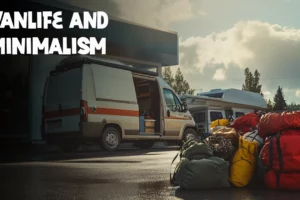
When a breakdown turns your hassle into an unforgettable road trip.
What do you do when your van decides to break down miles away from any garage? Breakdowns in van life are the nightmare lurking around every corner, threatening your road trip. But with tools like a multi-tool kit or a tire repair spray, combined with a method to diagnose mechanical issues, you can turn it into just a little adventure to share around a campfire. Discover the reflexes to adopt, tips to save on repair costs, and emergency solutions tested by experienced van lifers, whether you’re in the wild or abroad.
Quiz: Are You Really Ready to Face a Breakdown?
Check the items you own or master to discover your level of preparation
Part of this article • Takes a few seconds to complete
Better Safe Than Sorry: Preparing to Handle Breakdowns with Ease
Know Your Vehicle Inside and Out
Spending days stuck on the side of the road due to a minor issue can be a real nightmare when you’re in a camper. Sure, not everyone is a top-notch mechanic (trust me, I know), but knowing your van inside and out can save you a lot of hassle. Read your manual like it’s a survival guide, and in this age of social media, don’t hesitate to check out some YouTube tutorials: you’ll learn how to locate fuses, check your fluid levels (oil, coolant), and decode your electrical panel. If you plan to live the nomadic life year-round, run a few breakdown tests before hitting the road. Even with a bit of luck, it’s not impossible you’ll need to fix something one day.
The Essential Toolbox
Personally, I recommend packing some must-have tools before you head out. Of course, it’ll depend on the type of camper you have. The more space you have, the more tools you can bring. But for us, here’s the essentials to toss in your bag:
| Category | Main Items | Use | Practical Tip |
|---|---|---|---|
| Basic Tools | Wrenches, socket set, screwdrivers, pliers, utility knife, hammer | Perform simple repairs and adjust furniture | Choose high-quality tools to avoid bending |
| Electrical / 12V | Multimeter, fuses, electrical tape, wires, connectors, headlamp | Diagnose electrical issues and fix small circuits | Organize your fuses by size in a labeled box |
| Mechanical Emergencies | Jack, tire iron, jumper cables, 12V compressor | Change a tire, restart the engine, or inflate a tire | Always test your gear before setting off on a trip |
| Engine Maintenance | Oil, coolant, gloves, rags | Regularly check and top off fluid levels | Keep a small mechanical kit accessible from the outside |
| Minor Repairs | Epoxy glue, wire, duct tape, zip ties, screws | Address a broken part or a loose assembly | (Tip: duct tape can often save the day) |
| Living Quarters | Faucets, batteries, spare bulbs | Maintain hygiene! | Since we bought our camper, we’ve already had to replace the kitchen faucet twice; they’re electric and mechanical plastic faucets, and it’s a real hassle |
| Safety & Comfort | Gloves, work light, first aid kit | Work safely and manage minor injuries | Always keep this section within immediate reach |
A lightweight but complete kit can handle 80% of common breakdowns.
Breakdown on the Road: Your Quick Diagnostic Guide on What to Do
Step 1: Safety First
Before you even try to figure out what’s wrong, protect yourself. Turn on your hazard lights right away. Pull over as far away from traffic as you can. Put on your safety vest before exiting on the passenger side. Set up your warning triangle at a safe distance to alert other drivers. On a national road, place it at least 100 feet (30 meters) behind your vehicle.
On the highway, get behind the guardrails. They say the average lifespan of a person on the highway who isn’t behind those rails is about 20 minutes, so let’s avoid taking any chances. If you can, and if they exist where you are, use the orange emergency call boxes to signal your location. The main takeaway here is, never stay close to a broken-down vehicle on a fast lane.
⚠️ The 5 Safety Reflexes in Case of Breakdown
Step 2: Quick Diagnostic
Take a deep breath, you need to stay calm, or you’ll lose your focus. Check the dashboard lights. A lit engine light could mean a dead battery. Any strange noises or smells? Check the electrical system. If the lights work but the engine doesn’t, the issue might be with the chassis battery. To help you out, here’s a quick diagnostic checklist.
| Symptom | Possible Cause | What You Can Check Yourself | When to Call a Pro? |
|---|---|---|---|
| Engine won’t start | Dead chassis battery | Test the headlights. Try a jump start with cables | If that doesn’t work |
| Engine “coughs” but won’t start | Fuel or ignition issue | Check the fuel tank and type of fuel | Contact a pro immediately |
| Flat tire | Puncture | Use a tire repair spray or change the tire if you know how | If you don’t have a spare tire |
| No water at the tap | Water pump primed, blown fuse, empty tank, water heater in safety mode | Check the water level, the fuse, and try to re-prime | If the problem persists |
| No 12V electricity | Auxiliary battery, blown fuse, circuit breaker | Check the voltage, the fuse, and the circuit breaker | If you can’t find the cause |
Mechanical Failure or Cell Issue: Identifying the Source of the Problem
Hover or click on each point to discover the details
A discharged battery can be recharged with a charger. Avoid leaving power-hungry devices plugged into the cigarette lighter. A dead battery requires replacement.
Various causes: incorrect pressure, overload, or wear. Regular checking prevents unexpected stops. Verify that your spare tire is usable.
A significant temperature change can deform the tire, creating a flat section. Result: significant vibrations that increase with speed.
May indicate a cold engine (normal) or a coolant problem. If smoke persists after startup, consult a mechanic.
Often comes from excess fuel, related to a clogged air filter. Cleaning or replacing the filter usually solves the problem.
Suggests piston ring wear. Engine oil burns in the cylinders. This signal deserves urgent mechanical expertise.
Powers living equipment. Can discharge due to bad weather, overconsumption, or blown fuse. An automatic protection box (like Victron) prevents battery damage.
Vibrations can electrically disconnect the pump. The pump can also lose its prime and require manual repriming.
When water is too cold, the heater goes into safety mode and opens the trap under the RV. Water drains from underneath instead of coming out of the faucet.
Often under windows, require urgent repair. Waterproof tape temporarily seals the crack. Annual seal inspection prevents these infiltrations.
Click on points for more details • 6 mechanical breakdowns + 4 living area breakdowns
Common Mechanical Failures
The engine battery is often the first thing to go. A dead battery can be recharged with a charger or a tow, especially if your battery serves both as a power source and an engine battery, which is a bit rare, let’s be honest. It’s not uncommon for some folks to leave a high-energy device plugged into the cigarette lighter, which can really drain your engine battery. A dead battery needs replacing. To avoid surprises, test it before every (long) trip.
Flat tires can have various causes: incorrect pressure, overloading, or wear and tear. Regular checks can prevent unexpected breakdowns. If your spare tire is unusable, it’s better to be prepared.
A flat tire can also be a problem. It might not just be flat; it could be distorted due to a significant temperature change. I once drove from France to Portugal in a camper that was shaking quite a bit, and I thought it was a suspension issue. Turns out, it was just one of the tires that had lost its shape, causing a flat spot. Every time the wheel turned, it created a vibration where the road met the flat part. I can tell you, the faster you go, the more horrible the vibration feels in the camper.
Engine problems are often indicated by colored smoke. White smoke can mean a cold engine or a coolant issue. Black smoke usually comes from too much fuel, often due to a clogged air filter. Blue smoke suggests worn piston rings. These signs deserve a professional look if the problem persists.
Common Electrical Failures
The auxiliary battery powers the onboard living equipment. A discharge can happen due to bad weather, overconsumption, or a blown fuse. A multimeter helps to diagnose quickly. If you have an electrical system with a panel, the best option is a little box that automatically disconnects your battery when it drops below a certain level. This helps prevent damage to your auxiliary battery. I know that with Victron, I have this little box that I can even turn on or off remotely via Bluetooth. I used to do that every night before bed, and it also helped eliminate all the little blue lights that were shining too brightly inside the camper.
Water systems can also frequently fail in a camper. Since they operate with a pump, it can disconnect electrically due to vibrations. I’ve had to prime the pump because it lost its prime, and I’ve also had instances where, when the water was too cold, the heater would go into safety mode and open the hatch underneath the camper. So when I turned on the water, instead of coming out of the faucet, it came out from under the camper.
Water leaks, often under the windows, require emergency repairs. Waterproof tape can temporarily seal the crack. An annual inspection of the seals can prevent these leaks.
Time to Call for Backup: Insurance and Assistance, User Guide
A van breakdown requires quick thinking. Review your insurance policy before hitting the road to avoid any nasty surprises: repatriation coverage, accommodation costs, or mileage deductibles. Personally, when our clutch broke in the middle of nowhere on a Saturday night in Spain, right at the end of January, I was pretty glad I had chosen a solid insurance plan that could come to our rescue first thing Monday morning. The choice of vanlife insurance determines these coverages.
Before you head out, check your coverage for remote breakdowns, accommodation while repairs are made, and repatriation. Some policies include 24/7 assistance for mechanical or electrical issues. For international trips, make sure to confirm international towing. For example, some packages eliminate the mileage deductible, so you won’t have to pay for a tow just 6.2 miles (10 km) from home.
The Big Day: Contact Your Assistance
In case of a breakdown, follow these steps:
- Gather your policy number and the insurance contact. Keep them in an easily accessible spot, even without battery, like a leather case attached to your van key.
- Provide your exact location: mile marker, GPS coordinates, or parking area.
- Describe the issue: engine, battery, fuel, or water system (e.g., “Problem with potable water supply”).
- Note the case number and the representative’s name for follow-up.
Whether through an app or a phone call, stay organized. Also, check if your insurance offers a rental vehicle: it’s a real lifesaver when you have a trip to keep.
When Your House on Wheels is Out of Commission
Plan B for the Night: Where to Sleep When Your Vehicle is in the Shop?
If you break down, the key is to find a roof over your head quickly. Here are some options that fit your budget.
- Reach out to family or friends. Opt for short stays so you don’t overwhelm your hosts.
- Use apps like Couchsurfing. Choose profiles with recent reviews to avoid any nasty surprises.
- Budget $27 to $54 per night for budget accommodations. Go for flexible bookings.
- If repairs take a while, consider Airbnb.
Some insurance policies cover 1 to 2 nights in a hotel. Check your policy details to be prepared.
The Bottom Line: Your Financial Safety Net
Breakdowns can be expensive. Have a financial cushion to avoid stress. Here are some concrete examples.
We’ve written articles on the cost of maintaining a converted vehicle, but keep in mind that in an emergency, it could cost you more! (easily expect 30% more!)
What to Do with Your Stuff?
Some garages will let you leave a few belongings. But if not, here’s a quick logistical solution.
- Pack a light bag (11 lbs max) with documents, your laptop, and clothes for 2-3 days. Don’t forget a basic kit (charger, toothbrush).
- Store the rest in a garage (if possible) or a storage unit ($11 to $33 per month for 54 sq ft).
- If in doubt, bring your belongings to local contacts. Offer a service exchange to cut costs.
Car Trouble Abroad: A Bit of a Blessing in Disguise
Communicating with the Mechanic: The Language Barrier
It all depends on the country where your car breaks down and your level of English. If you and the mechanic have some basic understanding, you’ll manage the conversation without too much hassle. But if neither of you really speaks the language, things can get a bit tricky (and gestures will quickly become your best friend).
Fortunately, today, tools like Google Translate or even ChatGPT can save the day. You speak in your language, the mechanic speaks in theirs, and artificial intelligence bridges the gap between you two. Whether in instant chat mode or text scan, these tools translate your exchanges and help explain a breakdown, a faulty part, or a suspicious noise without the stress.
Just keep a few universal keywords in mind (it always helps). For example: flat tire for a blown tire, brake pad for a brake pad, or timing belt for a timing belt. And before any repairs, don’t forget to ask for a written estimate (in English quote, in Spanish presupuesto). This will save you from nasty surprises when it’s time to pay the bill.
Insurance and Specific Procedures
Make sure your international insurance covers you with the green card, a document proving your valid insurance in Europe. If your vehicle needs to be towed back, expect costs that could reach up to $2,100 depending on the distance. Keep all your receipts: they’ll serve as proof for partial reimbursement through your insurance. In Spain, always ask for the hoja de reclamaciones, an official complaint form in case of disputes.



